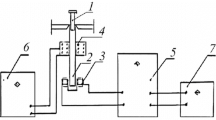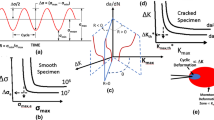Abstract
The fatigue crack growth behavior resulting from a single overload is investigated. In order to clarify the mechanism of overload on fatigue crack growth, the processes of crack closure and opening and their stress levels are monitored by strain gages placed on the back surface of specimens, and the fracture surface morphologies are examined by the microfractography. Experimental results may be used to explain quantitatively the mechanisms of retardation and delayed retardation after a single overload.
Similar content being viewed by others
References
Clarke, G. A., et al.,J. Testing and Evaluation,7, 1(1979), 49.
Paris, P. C. and Hermann. L., Measurements and analytical models for crack closure in fatigue, Paper presented at 14th International Congress on Theoretical and Applied Mechanics, Delft (1976).
Budiansky, B. and Hutchinson, J. W., Analysis of closure in fatigue crack growth,Journal of Applied Mechanics 45(1978), 267–276.
Author information
Authors and Affiliations
Rights and permissions
About this article
Cite this article
Bingxian, Y. Experimental studies on the effect of overload on fatigue crack growth. Acta Mech Sinica 2, 146–157 (1986). https://doi.org/10.1007/BF02485855
Received:
Issue Date:
DOI: https://doi.org/10.1007/BF02485855




